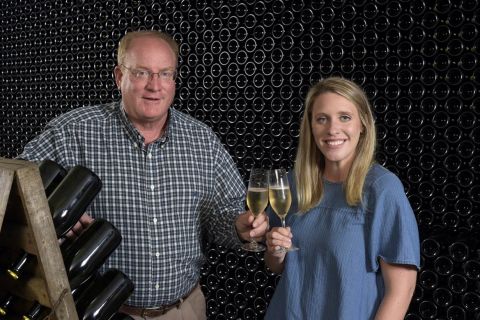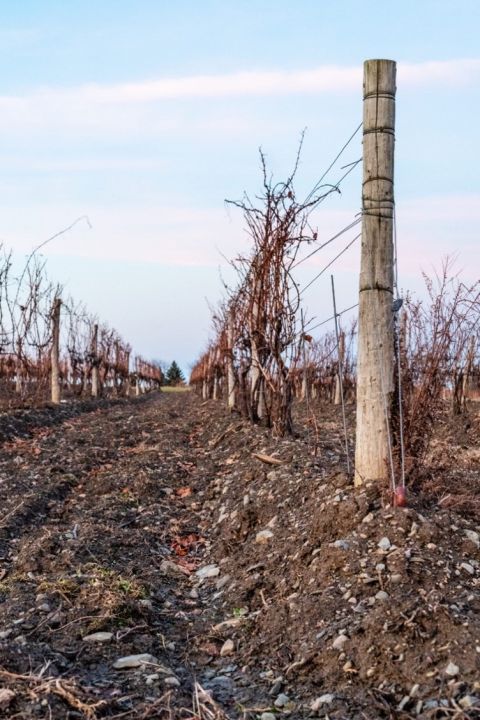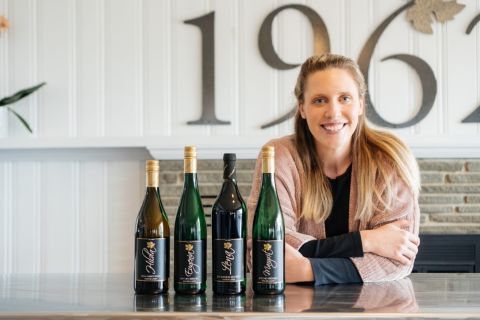Jerry Smith's entry to our old-vine writing competition is about an acre of 53-year-old Riesling. He writes, 'I’m a veterinarian by trade. Wine lover, WSET diploma student, home winemaker, wine blogger, all as an amateur. I have great respect for Finger Lakes wine at its highest levels of quality, and for the people that produce these hidden gems. I’m friends with Meaghan Frank, but we have no financial ties. (Although I might take Fred up on his offer of a library tasting sometime.) Feel free to check out my ramblings about the Finger Lakes at flxvoices.com.' See our WWC21 guide for more old-vine competition entries.
I’d like to talk about an acre of Riesling on the west side of Keuka Lake, in the Finger Lakes Region of New York State. For most of its life, this plot has simply been known as Keuka Block 8A, and it has added its character to countless blends over the years. That these vines have survived for over half a century is a testament to the brilliance and foresight of one man. Today, however, they also pay tribute to the extraordinary woman who built a legacy by his side.
Dr. Konstantin Frank was a man known by many names; father of vinifera in the Finger Lakes, the Robert Mondavi of the East, the mad doctor on the hill. He arrived in New York in 1951 with a PhD in viticulture and enology, decades of experience managing vinifera vines in cold climates, and great confidence that vinifera could be grown successfully in the Finger Lakes. Konstantin believed that European varieties made superior wines, and he wanted his adopted countrymen and women to have the best of everything. His grandson, Fred Frank, describes him as a great American patriot, a man literally born on the Fourth of July.
Konstantin knew that proper rootstocks were necessary to grow vinifera here. He planted his first vines in 1958 and took care to use rootstocks that were resistant to phylloxera. He warned California growers against the use of AXR1, which had to be uprooted En masse in the decades ahead. He also recognized that the graft union was the most vulnerable part of the vine and developed the practice of “hilling up” the vines in the fall. This involved using a specially designed plow to mound soil up over the graft union and part of the vinifera trunk. In a very cold year, when the canes, cordons, and even trunks are threatened, the graft union and the part of the scion covered by soil is protected. Even if most of the vine is lost, this section of the vinifera scion survives and new shoots can be trained from its basal buds. This technique allows the vines to (barely) survive the harshest of Finger Lakes winters. It is the reason we have old vinifera vines to even talk about in the Finger Lakes, and Konstantin’s methods have become standard practice today.
“Konstantin and Eugenia (Bartle) met in 1923 in Selz while Konstantin was working as a schoolteacher. Eugenia always pushed Konstantin to follow his dreams … In 1925 she encouraged Konstantin to finish his degree in agriculture. Through the decades, Eugenia worked tirelessly to keep the family together as they survived the Russian Revolution, two world wars, and … starting a new life in America. She devoted herself to their American dream of founding a winery. While Konstantin was in the vineyards conducting his research, Eugenia welcomed guests, developed her gardens, hand-labeled bottles, worked in the vineyards and kept the newly formed winery strong. Towards the end of Konstantin’s life, his palate was not what it used to be. He would hand Eugenia a glass of the wine he was working on and … she would communicate with a glance if the wine was ready to be released or not.” (Biography from the Dr. Frank website.)
In other words, Eugenia (pronounced with a hard G) did what countless other women of her time did, worked tirelessly in the background, critical to the family’s success, while her husband received full credit. Eugenia existed in the shadow of a great man, all the while living a life to be marveled at. The Russian Revolution? Two world wars? I ponder the harrowing stories that lie behind those casual statements. Study Eugenia’s face in the 1930 photograph of her seated with Konstantin behind her. It is a serene face on the surface, there’s a touch of a smile, a glimpse of kindness. But there is iron there too, a fierce determination. I would not have wanted to be on the wrong side of this woman.
The Frank family is full of remarkable women; Margrit Frank, wife of Konstantin’s son Willy, who cooked excellent meals for important guests, and after Willy died ‘her regular evening routine … was to walk the property, pick up any litter, water all the plants, and make sure everything was tidied for the next day.’ Or Konstantin and Eugenia’s daughter Hilda, who handled bookkeeping and finances. She and her husband, Walter Volz, ‘left stable careers in New Jersey for the uncertainty of the winery startup.’ When you study the history of the family, you find generation after generation of true partnerships. You could almost conclude that strong relationships are the backbone of a successful multigenerational family business.
Today the operations of the winery have been entrusted to a fourth generation, Meaghan Frank, great granddaughter of Eugenia and Konstantin, and another remarkable Frank woman. I had a very agreeable conversation with Meaghan and her father, Fred Frank, third generation and president of the winery. While father and daughter have similar ideas for the future of the winery, there’s just the faintest hint of disagreement over single vineyards. Fred feels the Finger Lakes name is the most important for broad recognition, and that the region is not ready yet for sub-AVA labeling. Meaghan thinks that specific labeling will highlight the more interesting sites, build the reputation of the region, and should be pursued. She’s in favor of a Keuka Lake AVA within the Finger Lakes, such as Seneca and Cayuga Lakes already have. She’s also in favor of single vineyard labeling for appropriate sites. And that brings us to Keuka Block 8A.
The oldest vines on the Keuka Lake site tend to be grouped around Konstantin and Eugenia’s home, an area of the vineyards informally called ‘The Farm’. The Riesling vines of Keuka Block 8A were planted in 1968. The soil is Glaciated Shallow Slate Loam. Fred explains that Konstantin used a massive single bladed plow pulled by a bulldozer to break up the layers of shale so the roots could dig deep. The site is at 1130’ of elevation, and slopes down to Keuka Lake, about a half mile away. Meaghan explains that they ferment many small batches for blending the forty or so labeled wines produced yearly. Block 8A was historically used in these blends, but consistently showed unique attributes like lime zest and peach notes, a mineral focus, freshness, and produced what she calls ‘a linear wine’. Meaghan has created a line of fine wines, under the Helm Series label, that are meant to honor and draw attention to the women of the family. This special block of Riesling seemed perfect for the Eugenia label. The Helm Series also includes a Margrit Riesling, a Hilda Chardonnay, and a Lena Reserve Red (named after another daughter of Konstantin and Eugenia). Meaghan says that these wines are meant to represent the pinnacle of Dr. Frank’s production.
As I read about Eugenia and the other women of the Frank family, I’m struck by the notion that they were symbolic of their times, struggling in the background, giving up something of their personalities, their dreams, their lives, for the better good of the family and the business. It’s a little like a unique plot of grapevines, perhaps that acre of vines called Keuka Block 8A, giving up its own special qualities for decades, to make the final blend more complex, more interesting, more complete. How right it seems that this newly renamed plot of vines, and the wine made from its harvest, should honor the uniqueness of this amazing woman. It’s beautiful, poetic even.
Sometimes there is a symmetry to life, or perhaps it’s a full circle, seasonal thing. I get that feeling while savoring a glass of Eugenia Riesling, looking at photos of her and Konstantin. Two in particular seem to represent different sides of their successful love story. The first is the one from 1930, with Eugenia seated in front of Konstantin. Both are dressed formally, Konstantin leaning a little casually in his suit, not quite in the background, but not in front either. In the second photo they are old, Konstantin evaluating a wine with Eugenia sitting quietly behind him, perhaps waiting to be handed the glass for her final glance of approval. A couple grown so close and intimate they could communicate without words. This is the partnership that created a dynasty, and it is a dynasty, albeit a humble one. One so personal you can reach out and touch it, perhaps even become a tiny part of it. Enjoy a glass of Eugenia Riesling while sitting on a bench in her garden. Gaze at the vineyards stretching down towards the lake. Marvel at this acre of unique old vines. They’re here because of the vision of one man and the tireless support of his wife. His partner. Perhaps think about Keuka Block 8A, Eugenia’s Block, as a third photograph. One where this extraordinary couple is sitting side by side, as equals.
The photos have been provided by Jerry Smith. The top photo is of Konstantin and Eugenia Bartle on their porch.






